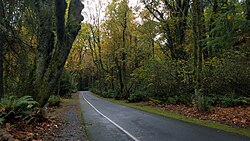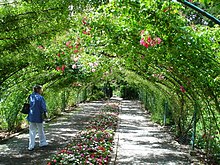Point Defiance Park
| Point Defiance Park | |
|---|---|
 Old growth forest along Five Mile Drive | |
| Location | 5400 N. Pearl St. Tacoma, Washington 98407 |
| Coordinates | 47°19′N 122°32′W / 47.31°N 122.53°W |
| Area | 760 acres (3.1 km2) |
| Operated by | Metropolitan Park District of Tacoma |
| Visitors | Over 3 million |
| Open | 30 minutes before sunrise to 30 minutes after sunset |
| Parking | Free |
| Website | Official website |
Point Defiance Park in Tacoma, Washington is a large urban park in the United States. The 760-acre (3.1 km2) park includes Point Defiance Zoo & Aquarium, the Rose Garden, Rhododendron Garden, beaches, trails, a boardwalk, a boathouse, a Washington State Ferries ferry dock for the Point Defiance-Tahlequah route to Vashon Island, Fort Nisqually, an off-leash dog park, and most notably a stand of old-growth forest. It receives more than three million visitors every year. Point Defiance Park is maintained and operated by the Metropolitan Park District of Tacoma.
Wildlife
Point Defiance Park offers something for all its visitors, both wildlife and people. Not all the wild animals are confined inside Zoo & Aquarium. From high cliffs overlooking the Tacoma Narrows people can watch bald eagles feed on salmon runs passing through on the strong tidal currents. Their calls can be heard from their nests in the old growth forest that is preserved and make up the northern 400 acres (1.6 km2) of the park.
In winter, sea lions migrating from California feed in the swirling tides beneath the Gig Harbor overlook on the northernmost point of the peninsula. Harbor seals are common near the tip of the point most of the year. Seal pups are frequently observed north of Owen Beach in late summer and early fall (humans and their dogs should keep their distance to avoid spooking the pups.)
The park also provides habitat for mule deer, red foxes, pileated woodpeckers, Douglas squirrels, and raccoons.
Endangered species: One of the features of the park is to sit in quiet contemplation in one of the Japanese Gardens. At sunset, wolves howl as the sun sinks into the tall trees with the Olympic Mountains silhouetted on the horizon. The wolves are temporary guests as part of a restoration project for endangered species that the Zoo & Aquarium and Northwest Trek Wildlife Park sponsor.
Recreation
As the largest urban park in Pierce County, the network of roads and trails weaving through the forest preserve provides a quiet retreat for joggers, cyclists, hikers. Trails are marked with symbols. Portions of The Five Mile Drive are closed to cars on Saturday. There are many hiking trails along Pt. Defiance's cliffs, that have sweeping views of Vashon Island, Dalco Passage, Gig Harbor, and the Tacoma Narrows Bridge. The road network also passes by Fort Nisqually.

From Owen Beach, kayakers launch and ride the strong currents north into the tidal rips. Fishermen drift in these tides waiting for salmon bound to south sound rivers. The 100-foot-tall (30 m) cliffs provide a buffer. Gliding out into the narrows, kayakers find a quiet oasis in the middle of an urban environment. There are also many beach goers, willing to venture further up the peninsula.

History

Point Defiance Park began as a military reservation after the Wilkes Expedition visited Puget Sound in the 1840s to map the bays and estuaries. Wilkes is thought to have noted that with a fort positioned at the point, and at Gig Harbor across the narrows, one could "Defy" the world.[2] The high cliffs and prominent location were never used for military operations. In 1888, President Grover Cleveland authorized its use as a public park. By 1890, streetcars brought visitors to wander among the gardens. In 1903, a waterfront pavilion was completed. By 1907 a seaside resort designed by Frederick Heath offered heated saltwater bathing in a pavilion called the Nereides Baths located on a bluff above the boathouse.
Fort Nisqually is a replica of Hudson's Bay Company's presence in the region in the 19th century when the English trading company had trading forts stretching from Fort Vancouver on the Columbia River, Fort Nisqually on south Puget Sound near the Nisqually River and continuing to the Far North to Fort Yukon on the Yukon River in Canadian territory which later became the state of Alaska.
In recent years, Fort Nisqually programs invite traders, trappers and Indian tribes to dress in period costume and return to the fort replica for a weekend of re-enacting this early period of trade and travel through the region by dugout cedar canoe.[3]
In 2019, the city's second-division soccer team renamed itself to Tacoma Defiance in reference to the park.[4]
The park opened Frank Herbert Trail and Dune Peninsula in July 2019 to honor science fiction writer Frank Herbert, known for his Dune novels, who was born in Tacoma.[5]
Formal Gardens


The gardens remain today. Visitors find a Japanese Garden, Rose Garden, and Dahlia gardens surrounding the former superintendent's home. The home was built in 1898 in the year of the Yukon Gold Rush. The gardens are located near the park's main entrance on the approach to the Zoo & Aquarium. It is sited on a bluff looking down on a waterfront containing the boathouse, Anthony's Restaurant and Washington State Ferry landing providing access to Vashon Island. Other public gardens on site include the Native Plant, Herb, Fuchsia, and Iris gardens.
The prominent feature of the Japanese Garden is the Pagoda, built in 1914 as a streetcar station. When buses replaced street cars throughout the West, the Pagoda became a waiting area for buses in 1938. In 1963 it was transformed into a center for flower shows and social gatherings. The Pagoda and Lodge were refurbished in 1988. In 2011 the Pagoda was heavily damaged in an arson fire but beautifully restored. The Pagoda and Lodge are rented throughout the year for weddings and receptions.
Brownfields and boating facilities
After a century of depositing slag into the waters of Puget Sound, Asarco's Tacoma Smelter created a peninsula to form the park's protected harbor. The Tacoma Yacht Club sits on the peninsula's promontory as a guardian of snug harbor. A public boat launch at the entrance of the harbor is part of the park's recreational facilities.
Zoo & Aquarium
Science and Math Institute
In the fall of 2009, Tacoma Public Schools opened the Science and Math Institute (SAMI), a science- and math-centered magnet high school within Point Defiance Park. SAMI features classes on the beach, pagoda, forests, and Zoo. Metro Parks was approached by the school district and gave them space for portable classrooms.[6] The school has a concept and schedule similar to the district's other magnet high school, Tacoma School of the Arts (TSOTA).
Great American Place designation
The American Planning Association designated Point Defiance Park as a 2011 Great American Place.
Community Involvement
Tacomans appealed to President Grover Cleveland in 1888 to repurpose Point Defiance from a military reserve to a park; in 1905 President Theodore Roosevelt signed legislation giving city full title to park. The park's first superintendent, Ebenezer Roberts, asked schoolchildren in 1895 to donate rose clippings to start a rose garden; today gardens have expanded to include native plants, herbs, iris, dahlia, and fuchsia; volunteers contribute time and plants. Citywide 2005 Park Bond Program provides $5.5 million to improve Point Defiance Park; projects include restoration of the Pagoda, trail maintenance, soil decontamination and converting mowed turf to habitat plantings. More than 1,500 citizens have engaged in the park's 2005 Park Improvement Bond planning since the process began in 2008.
Diverse Landscapes and Activities
In addition to old-growth forest with 450-year-old Douglas fir (Mountaineers Tree) are 250-foot vertical bluffs exposing rich geology. Groups and individuals regularly gather at the park for picnics, weddings, organized runs, and other special events. Saturday and Sunday mornings Five Mile Drive outer loop closed to cars, giving pedestrians and cyclists free rein in park's most popular destination. It has an off-leash dog exercise area; fee-based attractions include Point Defiance Zoo & Aquarium.
References
- ^ Overland Monthly. LXVIII (3). September 1916.
{{cite journal}}: Missing or empty|title=(help) - ^ "Archived copy". Archived from the original on 2011-05-24. Retrieved 2010-09-27.
{{cite web}}: CS1 maint: archived copy as title (link) - ^ http://www.burkemuseum.org/ethnology/faq_nwcanoes
- ^ Baker, Geoff (January 30, 2019). "Sounders' second-division squad rebrands as Tacoma Defiance". The Seattle Times. Retrieved January 30, 2019.
- ^ Krell, Alexis (July 6, 2019). "The Dune Peninsula and Frank Herbert Trail — 'Tacoma's newest treasure' — are open". The Tacoma News-Tribune. Retrieved July 7, 2019.
- ^ :Tacoma Public Schools (2009-06-10). "SAMI". Retrieved 2009-06-10.


